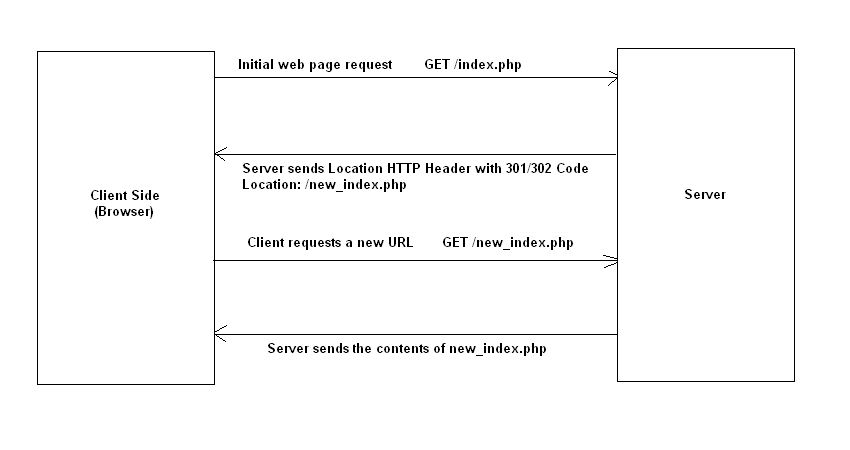Redirect tutorial in PHP
Redirect allows you to redirect the client browser to a different URL. You can use it when switching domains, changing your site structure, or switching to HTTPS.
In this article, I will show you how to redirect to another page using PHP. I'll explain exactly how PHP redirects work and show you what's happening behind the scenes.
Learn PHP with free online courses
If you want to learn PHP, check out our free online course on PHP Basics!
How does basic redirection work?
Before we dive into the details of PHP redirection, let’s take a quick look at how HTTP redirection actually works. Take a look at the image below.

Let’s understand what’s going on in the screenshot above:
- The client browser requests a specific page from the server. In the example above, the client requested the contents of the index.php file.
- The server received a request for the index.php file and wishes to notify the client that the file is no longer available or has been moved to a different location, and that it should look for a new file: new_index.php. PHP. The server sends the
Locationheader with the new URL and a 301 or 302 HTTP code. These are the HTTP codes used for redirects. - When the client browser encounters a 301 or 302 code, it knows that it must make another request to the new URL to get the content. It makes a request to get the
new_index.phpfile in the example above. - Finally, the server sends the contents of the new URL.
This is how basic HTTP redirection works. In the next section, we will discuss how PHP redirection works.
How Redirects Work in PHP
In PHP, when you want to redirect a user from one page to another, you need to use the header() function. The header function allows you to send a raw HTTP location header, which performs the actual redirection we discussed in the previous section.
How to use the header function
Let's take a look at the syntax of the header() function.
header( $header, $replace, $http_response_code )
-
$header: This is the HTTP header string you want to use. In our case, we will use theLocationheader for redirection. -
$replace: This is an optional parameter indicating whether the header should replace a previous similar header. -
$http_response_code: It allows you to send a specific response code.
Now, let’s look at the following examples to see how they work together.
<?php
// index.php
header("Location: https://www.yoursite.com/new_index.php");
exit();
?>
When the above script is executed, the client browser will be redirected to http://www.yoursite.com/new_index.php. Behind the scenes, it sends the raw HTTP Location header along with a 302 status code. The 302 status code is used for temporary redirects, but if you want a permanent redirect, you can pass a 301 status code in the third parameter as shown in the following code snippet.
<?php
// index.php
header("Location: http://www.yoursite.com/new_index.php", TRUE, 301);
exit();
?>
301 Permanent redirects allow you to notify search bots that the page is no longer available and can be replaced with a new page.
Why use the Die() or Exit() function after a header redirect?
Eagle-eyed users will notice that I used the exit() function in the above example. In fact, you must use the exit() or die() function immediately after the header redirection to stop script execution and avoid any undesirable results.
Therefore, it is always recommended to use one of these functions after a redirect.
Notable Error: Header Sent
If you are an experienced PHP programmer, I am sure that you have encountered this famous PHP error at some point in your daily PHP development. However, for beginners, encountering this error is really annoying as it is difficult to debug and fix. In most cases, they don't even know it's caused by a header redirect.
The rule of thumb is that when you use the header() function in a script, you need to make sure no output is sent before it. Otherwise, PHP will complain with a "Header Sent" error. This can happen even if you send a space before using the header function.
in conclusion
In this article, we discussed one of the important features of PHP programming: redirection. First, we looked at the basics of HTTP redirection and then demonstrated how it works in PHP.
The best PHP scripts on CodeCanyon
Explore thousands of the best and most useful PHP scripts ever created on CodeCanyon. With a low-cost one-time payment, you can purchase one of these high-quality WordPress themes and improve the website experience for you and your visitors.

Here are some of the best-selling and up-and-coming PHP scripts available on CodeCanyon in 2020.




The above is the detailed content of Redirect tutorial in PHP. For more information, please follow other related articles on the PHP Chinese website!

Hot AI Tools

Undresser.AI Undress
AI-powered app for creating realistic nude photos

AI Clothes Remover
Online AI tool for removing clothes from photos.

Undress AI Tool
Undress images for free

Clothoff.io
AI clothes remover

AI Hentai Generator
Generate AI Hentai for free.

Hot Article

Hot Tools

Notepad++7.3.1
Easy-to-use and free code editor

SublimeText3 Chinese version
Chinese version, very easy to use

Zend Studio 13.0.1
Powerful PHP integrated development environment

Dreamweaver CS6
Visual web development tools

SublimeText3 Mac version
God-level code editing software (SublimeText3)

Hot Topics
 1377
1377
 52
52
 PHP 8.4 Installation and Upgrade guide for Ubuntu and Debian
Dec 24, 2024 pm 04:42 PM
PHP 8.4 Installation and Upgrade guide for Ubuntu and Debian
Dec 24, 2024 pm 04:42 PM
PHP 8.4 brings several new features, security improvements, and performance improvements with healthy amounts of feature deprecations and removals. This guide explains how to install PHP 8.4 or upgrade to PHP 8.4 on Ubuntu, Debian, or their derivati
 How To Set Up Visual Studio Code (VS Code) for PHP Development
Dec 20, 2024 am 11:31 AM
How To Set Up Visual Studio Code (VS Code) for PHP Development
Dec 20, 2024 am 11:31 AM
Visual Studio Code, also known as VS Code, is a free source code editor — or integrated development environment (IDE) — available for all major operating systems. With a large collection of extensions for many programming languages, VS Code can be c
 How do you parse and process HTML/XML in PHP?
Feb 07, 2025 am 11:57 AM
How do you parse and process HTML/XML in PHP?
Feb 07, 2025 am 11:57 AM
This tutorial demonstrates how to efficiently process XML documents using PHP. XML (eXtensible Markup Language) is a versatile text-based markup language designed for both human readability and machine parsing. It's commonly used for data storage an
 PHP Program to Count Vowels in a String
Feb 07, 2025 pm 12:12 PM
PHP Program to Count Vowels in a String
Feb 07, 2025 pm 12:12 PM
A string is a sequence of characters, including letters, numbers, and symbols. This tutorial will learn how to calculate the number of vowels in a given string in PHP using different methods. The vowels in English are a, e, i, o, u, and they can be uppercase or lowercase. What is a vowel? Vowels are alphabetic characters that represent a specific pronunciation. There are five vowels in English, including uppercase and lowercase: a, e, i, o, u Example 1 Input: String = "Tutorialspoint" Output: 6 explain The vowels in the string "Tutorialspoint" are u, o, i, a, o, i. There are 6 yuan in total
 Explain JSON Web Tokens (JWT) and their use case in PHP APIs.
Apr 05, 2025 am 12:04 AM
Explain JSON Web Tokens (JWT) and their use case in PHP APIs.
Apr 05, 2025 am 12:04 AM
JWT is an open standard based on JSON, used to securely transmit information between parties, mainly for identity authentication and information exchange. 1. JWT consists of three parts: Header, Payload and Signature. 2. The working principle of JWT includes three steps: generating JWT, verifying JWT and parsing Payload. 3. When using JWT for authentication in PHP, JWT can be generated and verified, and user role and permission information can be included in advanced usage. 4. Common errors include signature verification failure, token expiration, and payload oversized. Debugging skills include using debugging tools and logging. 5. Performance optimization and best practices include using appropriate signature algorithms, setting validity periods reasonably,
 7 PHP Functions I Regret I Didn't Know Before
Nov 13, 2024 am 09:42 AM
7 PHP Functions I Regret I Didn't Know Before
Nov 13, 2024 am 09:42 AM
If you are an experienced PHP developer, you might have the feeling that you’ve been there and done that already.You have developed a significant number of applications, debugged millions of lines of code, and tweaked a bunch of scripts to achieve op
 Explain late static binding in PHP (static::).
Apr 03, 2025 am 12:04 AM
Explain late static binding in PHP (static::).
Apr 03, 2025 am 12:04 AM
Static binding (static::) implements late static binding (LSB) in PHP, allowing calling classes to be referenced in static contexts rather than defining classes. 1) The parsing process is performed at runtime, 2) Look up the call class in the inheritance relationship, 3) It may bring performance overhead.
 What are PHP magic methods (__construct, __destruct, __call, __get, __set, etc.) and provide use cases?
Apr 03, 2025 am 12:03 AM
What are PHP magic methods (__construct, __destruct, __call, __get, __set, etc.) and provide use cases?
Apr 03, 2025 am 12:03 AM
What are the magic methods of PHP? PHP's magic methods include: 1.\_\_construct, used to initialize objects; 2.\_\_destruct, used to clean up resources; 3.\_\_call, handle non-existent method calls; 4.\_\_get, implement dynamic attribute access; 5.\_\_set, implement dynamic attribute settings. These methods are automatically called in certain situations, improving code flexibility and efficiency.







